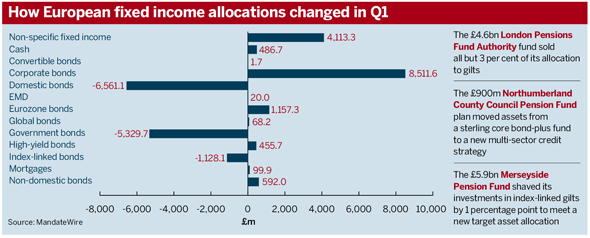UK pension funds were at the forefront of European institutional investors dumping government bonds for higher-yielding fixed income assets in the first three months of 2014, investment data have shown.
Data from Financial Times service MandateWire show institutions sold £5.3bn of government bonds in Q1 (see graph). This was in stark contrast with data from the previous quarter which show inflows of £6.6bn into government paper.

The £4.6bn London Pensions Fund Authority was one such fund, selling all but 3 per cent of its allocation to gilts at the beginning of the year.
A major beneficiary was the corporate bond market, which saw inflows of £8.5bn, nearly matching the £8.6bn ploughed into the asset class in the last three months of 2013.
Despite gilt yields beginning to rise, they are starting from a very low base point, said Simeon Willis, principal consultant at consultancy KPMG. “They’re still pretty low based on what they were in 2011,” said Willis.
As a result, many investors have decided to invest in more diverse and higher-yielding fixed income assets, though some have retained synthetic exposure to gilts rather than “investing hard cash in them”, added Willis.
“What that means is you can get the benefits of hedging liabilities but without having to tie up your money in a low-yielding asset,” he said.
Phil Edwards, European director of strategic research at consultancy Mercer, said some schemes have opted for emerging market debt and high yield.
“Over the last year or so we have seen schemes, as a next evolution of that, allocate towards multi-credit strategies,” Edwards said.
But reducing gilts decreases the “mark-to-market liability matching provided by the asset”, Edwards added.
Consultants have also noticed a rise in schemes using liability-driven investment mandates in tandem with higher-yielding fixed income assets.
“Pension schemes are on this journey to close deficits,” said John Belgrove, senior partner at consultancy Aon Hewitt, adding that they also want to control risk without the related cost of having bonds.
As a result schemes have looked to “sweat” their gilts, he said.














